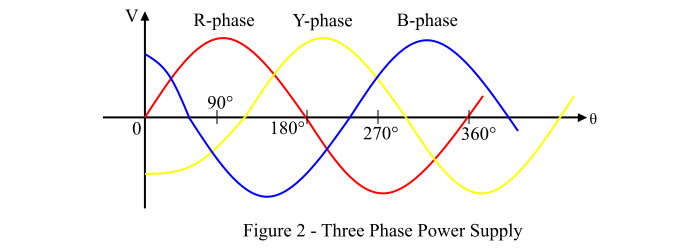
 Data Structure
Data Structure Networking
Networking RDBMS
RDBMS Operating System
Operating System Java
Java MS Excel
MS Excel iOS
iOS HTML
HTML CSS
CSS Android
Android Python
Python C Programming
C Programming C++
C++ C#
C# MongoDB
MongoDB MySQL
MySQL Javascript
Javascript PHP
PHP
- Selected Reading
- UPSC IAS Exams Notes
- Developer's Best Practices
- Questions and Answers
- Effective Resume Writing
- HR Interview Questions
- Computer Glossary
- Who is Who
Difference between Single-Phase and Three-Phase Power Supplies
The electric power supply we use in our day-to-day life is of AC or alternating current power supply. The alternating current or AC supply is the type of electric power supply in which the magnitude of the electric current changes continuously with time and the direction changes periodically. Almost 90% of the electric power supply that we use at our home, office, industries come from alternating sources like alternators.
Based on the number of phases in the supply system, the AC power supply can be classified into two types viz.
Single-Phase AC Supply
Three-Phase AC Supply
In this article, we will explain the differences between single phase and three phase power supplies. But, before that we will briefly introduce the single-phase power supply and three-phase power supply.
What is Single-Phase Power Supply?
A single-phase power supply is the type of AC power supply in which the AC electric power being distributed using only two conductors named phase and neutral. In practice, a sinusoidal AC power supply is used, the waveform of the single-phase power supply is shown in Figure-1. Where, the voltage in the single phase power supply attains its peak value at 90° during positive half-cycle and attains the maximum value at 270° during negative half cycle.

In the 1-phase power supply, the phase wire carries the electric current from source to load while the neutral wire provides the return path to the current. In India, the RMS value of voltage in a single phase supply is 230 V at 50 Hz frequency.
The main drawback of single-phase power supply is that the single phase power is of pulsating nature, which causes the vibrations in the motors. However, almost all residential power supplies are single phase which are used to run electrical appliances such as fans, coolers, air conditioners, lamps, etc.
What is Three-Phase Power Supply?
When AC electric power is distributed to the load using three line conductors, then the electric power supply is termed as three-phase power supply. In case of three-phase power supply, there are three line conductors for three phases and a neutral may also be there. The presence of neutral wire in the 3-phase power supply depends upon the type of the connection of the windings of the source and load, i.e. neutral is present in star connection, but not in delta connection.

In a three-phase power supply, there are three waveforms for each phase, which are 120° out of phase with each other. The waveform for the sinusoidal three-phase power supply is shown in the figure-2. From the waveform of the three-phase power supply, it can be noted that the average power never drops to zero, hence there is no pulsation of average power and hence no vibration in the electrical machines. The three-phase supply is widely used in industrial and commercial applications.
Difference between Single Phase and Three Phase Power Supplies
The key differences between single-phase and three-phase power supplies are shown in the following table
| Parameter | Single-Phase Power Supply | Three-Phase Power Supply |
|---|---|---|
| Description | The type of AC power supply in which there is only one voltage waveform, i.e. only one-phase is known as single-phase power supply. | The type of AC power supply which has 3 voltage waveforms, i.e. 3-phase is known as three-phase power supply. |
| Number of conductors required | Only two conductors viz. phase and neutral are required to supply the single phase power. | Three phase power supply requires at least three conductors for three phases, (four wires 3 line wires and 1 neutral in case of star connected system) for supplying the electric power to the load. |
| Number of voltage waveform | Single phase power supply has only one voltage waveform (practically a sinusoidal wave). | There are three voltage waves corresponding to three phases in case of three phase power supply. |
| Supply voltage (in India) | In single phase power supply, the supply voltage is 230 V with ±10 variation. | In three phase power supply, the line to line voltage is 440 V with ±10 variation. |
| Power delivered | The power delivered in single phase power supply is pulsating. | The power delivered by three-phase power supply is constant. |
| Parallel operation of difference supply systems | The parallel operation of different supply systems is not easy in case of 1-phase supply. | Three-phase supply provides easy parallel operation of different systems. |
| Circuit complexity | The circuit of single phase supply is very simple. | The circuit of three-phase supply is complicated. |
| Power transfer capacity | The power transfer capacity of 1-phase power supply is less. | The relatively more power can be transmitted in case of three-phase power supply. |
| Transmission efficiency | Single phase power supply has low transmission efficiency. | The transmission efficiency is high in case of three-phase power supply. |
| Conductor size | In single-phase power supply, the cross-sectional area of conductor used is large. | The three-phase power supply requires relatively smaller area of cross-section of conductor. |
| Size of machines (same power rating) | The single machine is larger in size. | The three-phase machines have relatively smaller size. |
| Power failure | The chances of power failure due to fault are higher because there is only one phase in 1-phase supply. If it fails, then there is no power. | The changes of power failure are less because a 3-phase supply has 3-phases. If there is fault in 1 or 2 phases, then power will be continuously delivered using remains phases. |
| Presence of neutral wire | Single phase power supply necessarily has neutral wire, which acts as return path for current. | In 3-phase power supply, neutral may or may not be present. It depends upon the circuit configuration, if star connection is used, then neutral will be there. If delta connection is used, no neutral will be there. |
| Production of rotating magnetic field | Single phase power supply cannot produce rotating magnetic field in electrical machines such as induction motor. | The three phase power supply can produce rotating magnetic field (RMF) in the electrical machines. |
| Suitability | Single phase power supply is suitable for power distribution over short distances. | Three phase power supply is used for long distance power transmission as well as high power distribution to run three-phase loads. |
| Conversion | Single phase power supply requires expensive converters to convert it into 3-phase supply. | Single phase supply can be directly taken from the three phase supply between one phase and neutral. |
| Economy | Single phase supply is less economical. | Three phase power supply is more economical than 1-phase supply. |
| Applications | Single phase supply is extensively used to power low power appliances used in home and offices. | Three phase power supply is used for supplying power to the heavy loads in industries. |
Conclusion
The most significant difference between a single-phase power supply and a three-phase power supply is that the 1-phase supply has a simple circuit of two wires to transfer the power to the small loads such as appliances used in houses and offices, while a 3-phase power supply is more economical for delivering high power to the heavy loads in industries.

